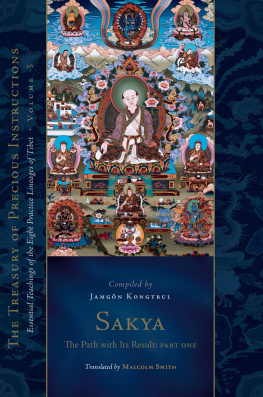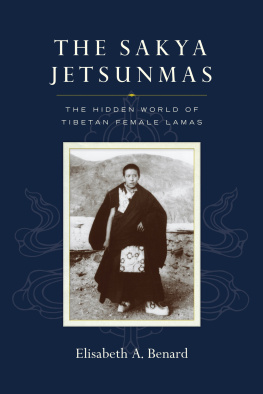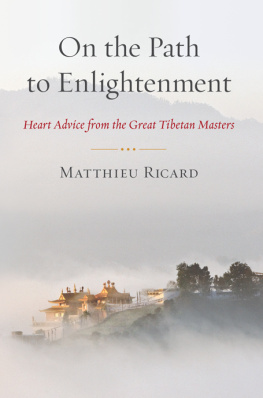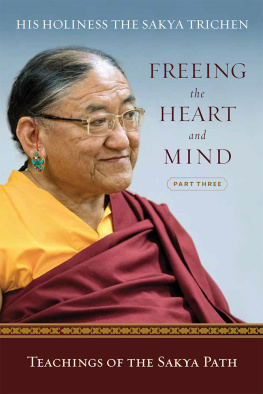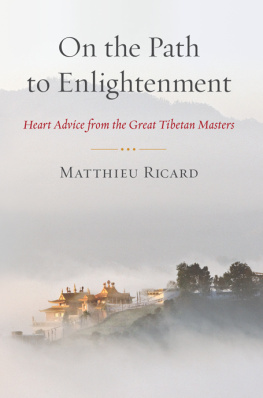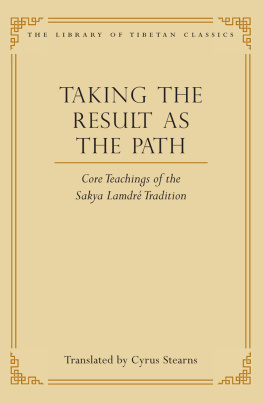TREASURES OF THE
SAKYA LINEAGE
TEACHINGS FROM THE MASTERS
Migmar Tseten

Shambhala
Boston & London
2011
Shambhala Publications, Inc.
Horticultural Hall
300 Massachusetts Avenue
Boston, Massachusetts 02115
www.shambhala.com
2008 Migmar Tseten
Cover art: Painting of Sakya Pandita Kunga Gyaltsen, collection of Shelley and Donald Rubin, used with permission. www.himalayanart.org
All rights reserved. No part of this book may be reproduced in any form or by any means, electronic or mechanical, including photocopying, recording, or by any information storage and retrieval system, without permission in writing from the publisher.
Library of Congress Cataloging-in-Publication Data
Treasures of the Sakya Lineage; teachings from the masters / [compiled by] Migmar Tseten.
p. cm.
eISBN 978-0-8348-2309-9
ISBN 978-1-59030-488-4 (pbk.: alk. paper)
1. Sa-skya-pa (Sect). I. Tseten, Migmar.
BQ7672.T74 2008
294.3923 22
2007033817
CONTENTS

Words of great masters are like water to the thirsty, medicine to the sick, and a guiding star to the lost. The teachings sow the seeds. Understanding and reflecting back upon them nurtures the sapling. But it is only by incorporating the essence of the words in daily living that many have been able to reap the sweet fruit of enlightenment.
It gives me much pleasure to introduce this compilation of short teachings by various Sakyapa masters and scholars. I appreciate Lama Migmar Tsetens endeavor to bring Dharma to laypeople in the form of this compact collection.
I am sure the contents of this book will benefit many seekers of the profound truth.
With my blessings for the success of all the noble efforts made toward propagating the peerless doctrine of the Enlightened One. By this merit, may all sentient beings achieve deliverance from suffering.

The Sakya Trizin
April 2007
The Sakya monastery in Tibet is the oldest continuously operating institution among the four lineages of Tibetan Buddhism today. Founded by Khon Konchog Gyalpo in the late eleventh century, it became home primarily to the lineage of teachings brought to Tibet from India by the famed translator Drogmi Lotsawa, and codified by the five founding masters of Sakya. Detailed information about the Sakya school and its origin and doctrines may be found in chapter 25.The central teaching of the Sakya school, the path and result ( lamdre ), is based on the practice of the deity Hevajra and the view of the inseparability of samsara and nirvana.
This collection covers a vast range of Buddhist topics within the three yanas, and is representative of the Sakya schools method of presenting the Dharma.
The Sakya school has long been known for its balanced approach to study and practice, never emphasizing one at the expense of the other. Another feature of the Sakya school is its commitment to preserving the Indian Sutra and Tantra traditions as fully as possible. The writings of Sakya scholars have been deeply influential in every school of Tibetan Buddhism, and they continue to be now.
This collection is important because it features the teachings of both contemporary and ancient Sakya masters, showing a thousand years of lineage continuity. The Sakya masters of the past are Jetsun Dragpa Gyaltsen, Sakya Pandita, Chogyal Phagpa, and Ngorchen Kunga Zangpo. The texts of Jetsun Dragpa Gyaltsen are translated from a collection of his mystical songs found in his collected works. The longest and most comprehensive of these songs is the Great Doha . Likewise, the texts by Sakya Pandita, Chogyal Phagpa, and Ngorchen Kunga Zangpo are taken from their collected works.
The contemporary masters included here are His Holiness Sakya Trizin, His late Eminence Chogye Trichen, Khenpo Appey, and Lama Migmar Tseten. The texts by H.H. Sakya Trizin and H.E. Chogye Trichen are edited from talks and teachings. The series of texts by Khenpo Appey are drawn from his teachings on Sakya Panditas masterpiece, Clarifying the Buddhas Intent . Lama Migmar Tsetens text is drawn from his teachings on the Abhidharmakosha of Vasubandhu.
The texts in this collection were selected from four anthologies privately published in a series called Visions .
ACKNOWLEDGMENTS
First of all, with profound respect, I would like to acknowledge H.H. Sakya Trizin and H.E. Ludhing Khenchen Rinpoche for their enlightened guidance, and to thank Khenpo Appey Rinpoche and Geshe Tashi Namgyal for their concise clarification of some critical points during the compilation of this text.
Next, I recall with gratitude the kindness of my teachers at the Tibetan Institute in Varanasi, India, who shaped my education in Buddhist philosophy: Gen Thupten Tsering (Gaden), Gen Yeshe Thapkhe (Drepung Loseling), Gen Tsultrim Gyatso (Drepung Gomang), and Gen Jampa Dhonyo (Sera), as well as Sakya Khenpo Tashi Sangpo and Sakya Tritso Khenpo.
I am grateful for my association with the Tibetan Institute and with Samdhong Rinpoche (the present prime minister of the Tibetan government in exile), who inspired me to dedicate my life to the Tibetan wisdom culture through the preservation of a distinct school of the Tibetan Buddhist tradition.
I also want to thank Shabdrung Rinchen Paljor Rinpoche, Thartse Rinpoche, Dzongsar Kyentse, Traleg Khyabgon, Tulku Thondup, Khenpo Gyatso, Lama Pema Wangdak, Lama Kalsang, Lama Jamyang Legshe, Professor Tashi Tsering, and Geshe Jamyang Tsultrim for their encouragement and support.
With deep appreciation, I give thanks to Kunga Namdrol and Ani Jamyang for their dedication during the various preparatory stages of this book.
The creation of this work would not have happened had it not been for Sam Bercholz, Hazel Bercholz, Sara Bercholz, Emily Bower, Ben Gleason, and Shambhala Publications, who originally conceived the idea for this edition. To them I am very grateful.
My sincere thanks goes to Jim Wilton for his legal advice and Tom Hlas for his help in creating and managing my website, www.lamamigmar.com.
I acknowledge the support of my colleagues Raymond A. Kahng, Dr. Bernard Steinberg, Greg Epstein, and the other chaplains at Harvard University. Working together is a joy.
To the Schaffer Foundation I extend heartfelt gratitude for their continued support of my translations and publications.
With profound devotion, I dedicate this book to the memory of His late Eminence Chogye Trichen Rinpoche and the late Khenpo Rinchen, without whom I would not have made a connection to the profound and vast lineage of the Sakya tradition.
Finally, I dedicate this book to the long life of His Holiness the Fourteenth Dalai Lama.

Jetsun Dragpa Gyaltsen (11471216)
Namo gurubhadraya.
To the gurus and personal deities residing inseparably,
who join all qualities to the mind stream,
I prostrate with pure body, speech, and mind;
I make an offering free from both grasper and grasped;
I praise with mind, beyond the activity of speech, free from proliferation;
I make a confession untouched by the sins of the three times;
I go for refuge without an object, free from fear;
I create limitless bodhichitta without objects,
the nature of which is dharmata, like space;
Next page

